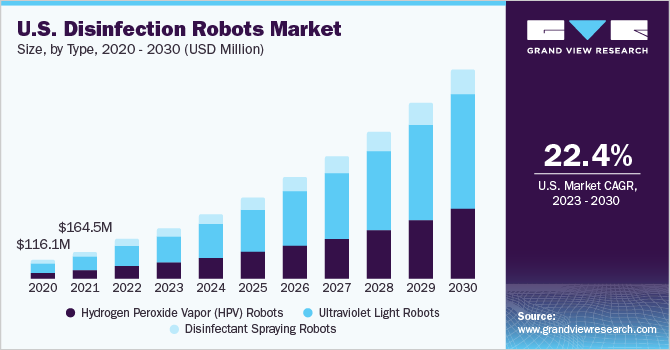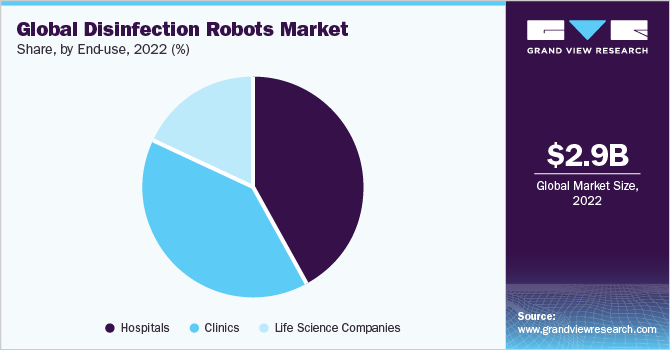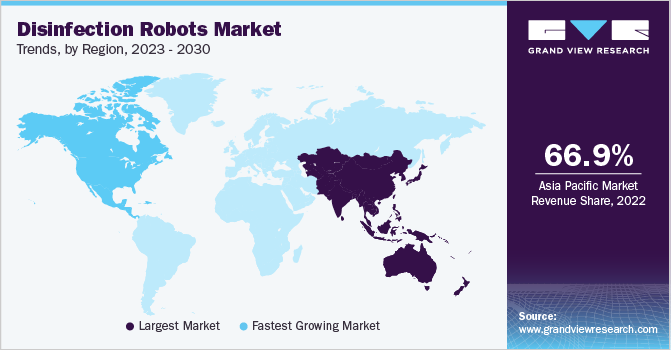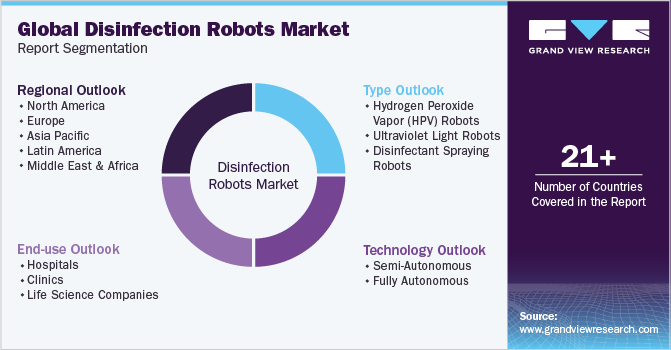
Disinfection Robots Market Size, Share & Trends Analysis Report By Type (HPV Robots, Ultraviolet Light Robots), By Technology (Semi-autonomous, Fully-autonomous), By End-use (Hospitals, Clinics), And Segment Forecasts, 2023 - 2030
- Report ID: GVR-4-68040-127-6
- Number of Pages: 120
- Format: Electronic (PDF)
- Historical Range: 2018 - 2021
- Industry:Healthcare
Report Overview
The globaldisinfection robots marketsizewas estimated atUSD 2.88 billion in 2022and is expected to grow at a compound annual growth rate (CAGR) of 19.9% from 2023 to 2030. The market’s growth is attributed to the increasing awareness and emphasis on hygiene and infection control in healthcare settings and labor and time savings offered by disinfection robots. In addition, advancements in robotics and AI technologies have enabled the development of sophisticated disinfection robots that can navigate complex environments, adapt to various surfaces, and employ multiple disinfection methods, such as UV-C light or chemical spraying. Moreover, the challenges of infectious diseases, such as COVID-19, have accelerated the need for advanced disinfection methods. Disinfection robots provide an efficient way to cover large areas quickly, aiding in reducing pathogen transmission.

The growing need for disinfection robots in hospitals to effectively control the spread of infectious diseases is a major driving force behind the rapid growth of the market. Hospitals and healthcare facilities have recognized the significant role of these robots in maintaining a safe and sanitized environment for patients, staff, and visitors. Disinfection robots offer a reliable and efficient solution, capable of covering extensive areas and reaching surfaces that might be difficult for manual cleaning to address. Their ability to deploy various disinfection techniques, such as UV-C light or chemical sprays, improves their effectiveness in eliminating pathogens. As hospitals prioritize infection prevention, the demand for disinfection robots continues to rise, creating a robust market growth trajectory driven by the imperative to ensure health and safety within medical settings.
Moreover, Hospital-acquired infections contribute to approximately 37,000 deaths annually in Europe and nearly 100,000 in the U.S. The financial burden of treating these infections amounts to about USD 7.5 billion in Europe and USD 6.5 billion in the U.S. Ultraviolet disinfection robots present a promising solution, capable of eradicating up to 99.9% of microorganisms within 10 minutes in a hospital room. While the room needs to be vacant during disinfection, the UV rays have no harmful impact. The shortage of workforce in hospitals is another significant factor driving the market growth. With increasing demands, hospitals often need help allocating sufficient staff to perform meticulous cleaning and disinfection tasks. Disinfection robots step in to fill this gap by offering an automated and efficient solution.
These robots can work tirelessly and consistently, reducing the reliance on manual labor for disinfection procedures. By addressing the workforce shortage issue, disinfection robots ensure that hospitals can maintain optimal cleanliness and infection control measures, ultimately contributing to patient safety and operational efficiency. The COVID-19 pandemic has swiftly propelled the acceptance of disinfection robots, extending their application beyond healthcare settings like hospitals to spaces, such as hotels, airports, and public transport. Simultaneously, the rise in antibiotic-resistant infections highlights the importance of infection prevention, especially within medical facilities. According to IFR World Robotics, sales of professional cleaning robots surged by 20% to 55 million in 2019 compared to the previous year, and this growth trend is projected to continue due to the global impact of COVID-19.
However, regardless of the potential benefits of disinfection robots, there are some challenges to overcome. One of the major concerns is the cost of maintaining and implementing these advanced robots. Despite high initial costs, supporters contend that long-term patient care and efficiency gains will surpass expenses. In addition, there are concerns about the possibility of losing jobs for the human workforce as robots take on more tasks. However, experts anticipate that integrating mobile robotics will lead to new roles in system development, maintenance, and operation, countering potential job losses.
Type Insights
The ultraviolet light robots segment accounted for the largest revenue share of 51.6% in 2022 and is expected to register the fastest CAGR of 20.7% over the forecast period. These robots use ultraviolet (UV) light, specifically UV-C light, to eliminate a wide range of pathogens, including bacteria, viruses, and other harmful microorganisms. UV-C light has been extensively studied for its germicidal properties and ability to break down the DNA and RNA of pathogens, rendering them inactive. They provide consistent and thorough disinfection without the use of chemicals, reducing the risk of human error and potential exposure to harmful substances. Moreover, UV robots can quickly disinfect large areas and surfaces, significantly reducing the time required for manual cleaning and disinfection.
此外,抛光工艺的开发和发布ogically advanced disinfection robots by key players to maintain their competitive edge is further boosting the market growth. For instance, The TMiRob, developed by a Chinese company, Taimi Robotics Technology, offers a versatile solution for disinfection with three distinct methods: UV,hydrogen peroxide, and plasma air filtration. These methods can be employed individually or combined based on specific disinfection requirements. Notably, some disinfection robots, like those from Indian manufacturer Milagrow and the collaboration between Siemens and Chinese partner Aucma, feature caterpillar tracks for enhanced mobility, allowing them to navigate challenging terrains and inclines. This innovation expands the operational versatility of disinfection robots beyond traditional wheeled models.
Technology Insights
The fully autonomous robots segment accounted for the largest revenue share of 58.3% in 2022 and is expected to continue its dominance growing at the fastest CAGR of 20.5% over the forecast period. This can be attributed to their ability to operate with minimal human intervention. These robots are equipped with advanced sensors, AI algorithms, and cameras that enable them to navigate and disinfect spaces independently. This level of autonomy ensures consistent and efficient disinfection, reducing the risk of human error and ensuring thorough coverage.
Fully autonomous robots can map and adapt to their environment, avoiding obstacles and adjusting their cleaning patterns. This technological advancement not only enhances the effectiveness of disinfection but also contributes to operational cost savings and time efficiency. As a result, the demand for fully autonomous disinfection robots has increased, making them a prominent choice for various industries seeking reliable and hands-free disinfection solutions.
End-use Insights
The hospital segment dominated the market and held the largest revenue share of 42.0% in 2022. Hospitals often have complex layouts with various rooms and surfaces that require frequent and thorough disinfection. Disinfection robots offer a systematic and efficient approach to covering large areas, including hard-to-reach spaces, which can be challenging for manual cleaning methods. Moreover, the challenges posed by healthcare-associated infections (HAIs) and the need to minimize the risk of cross-contamination have further accelerated the adoption of disinfection robots in hospitals. These robots provide a consistent and standardized disinfection process, reducing the potential for human error and enhancing overall hygiene levels.

The clinics segment is expected to witness the fastest CAGR of 20.8% over the forecast period. Clinics often need more staff resources, and healthcare professionals are occupied with patient care and other critical tasks. Disinfection robots offer an automated solution that complements existing cleaning practices, freeing up staff to focus on patient care. In addition, clinics, especially those specializing in specific medical treatments or procedures, require a high level of cleanliness and hygiene to prevent post-treatment infections. Disinfection robots provide consistent and thorough disinfection, reducing the potential for cross-contamination and enhancing the overall quality of care provided.
Regional Insights
Asia Pacific dominated the market and held the largest revenue share of 66.9% in 2022. The introduction of advanced disinfection robots by key players in the region and increasing government initiatives in the robotics market are the major factors driving the industry's growth. For instance, as per the news article published by Cutting Tool Engineering in January 2023, China undeniably leads as the world's fastest-expanding robot market. With the highest count of annual installations and an unbroken streak since 2016 of maintaining the largest operational robot stock annually, China's high technological adoption holds the potential to significantly fuel the market growth within the Asia Pacific region.

In addition, rising awareness about the significance of maintaining high hygiene standards, especially in the wake of the COVID-19 pandemic, has accelerated the deployment of these robots across the region. For instance, in April 2020, Hospitals in India increasingly adopted robotic solutions to minimize direct contact between COVID-19 patients and healthcare providers while enhancing screening efforts. The AIIMS hospital in Delhi introduced both floor disinfectant robots and humanoid robots within its COVID-19 wards to effectively manage infection control measures. North America is expected to witness the fastest CAGR of 22.7% over the forecast period.
这是由于高度发达的医疗正无穷rastructure and rising funding by the government & key players in the market to support robotics applications in healthcare settings. For instance, as per the article published by Brain Corp. in August 2020, Scripps Health, a nonprofit healthcare provider in San Diego, participated in Brain Corp.’s Robot Relief Program, an initiative that contributed cleaning robots and services to essential businesses amid the health crisis. As part of this effort, Scripps deployed robotic floor scrubbers at two facilities, including Scripps Memorial Hospital La Jolla and Scripps Mercy Hospital San Diego. The deployment began in June, with the first robot operating autonomously for an average of 2.5 hours every night at Scripps La Jolla. This program aimed to support infection control measures and enhance cleanliness in the healthcare environment.
KeyCompanies&市场份额的见解乐鱼APP二维码
Key companies are actively formulating strategic approaches to enhance their market presence and gain a competitive advantage within the sector. These key players are emphasizing strategic maneuvers, encompassing mergers & acquisitions, collaborative ventures, partnerships, substantial investments, and the introduction of innovative products to augment their capabilities and broaden their range of offerings. As the field of data analytics, machine learning, computer vision, and related technologies continues to evolve, the domain of medical service robotics is advancing towardincreased efficiency and autonomy in task execution. For instance, in January 2021, UBTECH unveiled its latest innovation, the ADIBOT UV disinfection products. Engineered to provide hospital-grade disinfection for facilities, the ADIBOT solution harnesses the power of UV-C light to neutralize COVID-19 and other hazardous bacteria and viruses. UV-C light has an established track record as a reliable technology for surface disinfection and has been successfully employed in hospitals globally for over three decades.Some of the major players in the global disinfection robots market are:
Blue Ocean Robotics
Xenex Disinfectant Systems
芬生技术(雷神UV-C)
Skytron (Infection Prevention Technologies)
Tru-D SmartUVC LLC
Akara Robotics Ltd.
Mediland Enterprise Corp.
Tmirob Technology
OTSAW Digital Pte. Ltd.
Bioquell PLC (Ecolab Inc.)
Bridgeport Magnetics
Ateago Technology
Disinfection Robots MarketReport Scope
Report Attribute |
Details |
Market size value in 2023 |
USD 3.60 billion |
Revenue forecast in 2030 |
USD 12.79 billion |
Growth rate |
CAGR of 19.9 % from 2023 to 2030 |
Base year for estimation |
2022 |
Historical data |
2018 - 2021 |
Forecast period |
2023 - 2030 |
Quantitative units |
Revenue in USD million/billion and CAGR from 2023 to 2030 |
Report coverage |
Revenue forecast, company ranking, competitive landscape, growth factors, and trends |
Segments covered |
Type, technology, end-use, region |
Regional scope |
北美;欧洲;亚太地区;拉丁美洲; MEA |
Country scope |
U.S.; Canada; Germany; UK; France; Italy; Spain; Denmark; Sweden; Norway; China; Japan; India; Australia; South Korea; Thailand; Brazil; Mexico; Argentina; South Africa; Saudi Arabia; UAE; Kuwait |
Key companies profiled |
Blue Ocean Robotics; Xenex Disinfectant Systems; Finsen Technologies (Thor UV-C); Skytron (Infection Prevention Technologies); Tru-D SmartUVC LLC; Akara Robotics Ltd.; Mediland Enterprise Corp.; Tmirob Technology; OTSAW Digital Pte. Ltd.; Bioquell PLC (Ecolab Inc.); Bridgeport Magnetics; Ateago Technology |
Customization scope |
Free report customization (equivalent up to 8 analyst’s working days) with purchase. Addition or alteration to country, regional & segment scope. |
Pricing and purchase options |
Avail customized purchase options to meet your exact research needs.Explore purchase options |
GlobalDisinfection Robots MarketReportSegmentation
This report forecasts revenue growth at regional and country levels and provides an analysis of the latest trends in each sub-segments from 2018 to 2030. For this study, Grand View Research has segmented the disinfection robots market report based on type, technology, end-use, and region:

Type Outlook (Revenue, USD Million, 2018 - 2030)
Hydrogen Peroxide Vapor (HPV) Robots
Ultraviolet Light Robots
Disinfectant Spraying Robots
Technology Outlook (Revenue, USD Million, 2018 - 2030)
Semi-Autonomous
Fully Autonomous
End-use Outlook (Revenue, USD Million, 2018 - 2030)
Hospitals
Clinics
Life Science Companies
Regional Outlook (USD Million, 2018 - 2030)
North America
U.S.
Canada
Europe
UK
Germany
France
Italy
Spain
Denmark
Sweden
Norway
Asia Pacific
China
India
Japan
South Korea
Australia
Thailand
拉丁美洲
Brazil
Mexico
Argentina
Middle East & Africa
South Africa
Saudi Arabia
UAE
Kuwait
Frequently Asked Questions About This Report
b.The global disinfection robots market was valued at USD 2.88 billion in 2022 and is estimated to reach USD 3.6 billion in 2023.
b.The global disinfection robots market is estimated to grow at a compound annual growth rate (CAGR) of 19.9% from 2023 to 2030 to reach USD 12.79 billion in 2030.
b.The hospital segment has dominated the disinfection robots market and held the largest revenue share of 42.0% in 2022. Hospitals often have complex layouts with various rooms and surfaces that require frequent and thorough disinfection.
b.Some of the major players in the disinfection robots market are: o Blue Ocean Robotics o Xenex Disinfectant Systems o Finsen Technologies (Thor UV-C) o Skytron (Infection Prevention Technologies) o Tru-D SmartUVC LLC o Akara Robotics Ltd o Mediland Enterprise Corporation o Tmirob Technology o OTSAW Digital Pte Ltd o Bioquell PLC (Ecolab Inc.) o Bridgeport Magnetics o Ateago Technology
b.The market’s growth is attributed to the increasing awareness and emphasis on hygiene and infection control in healthcare settings and labor and time savings offered by disinfection robots.





